2008 SUBARU TRIBECA child seat
[x] Cancel search: child seatPage 5 of 409
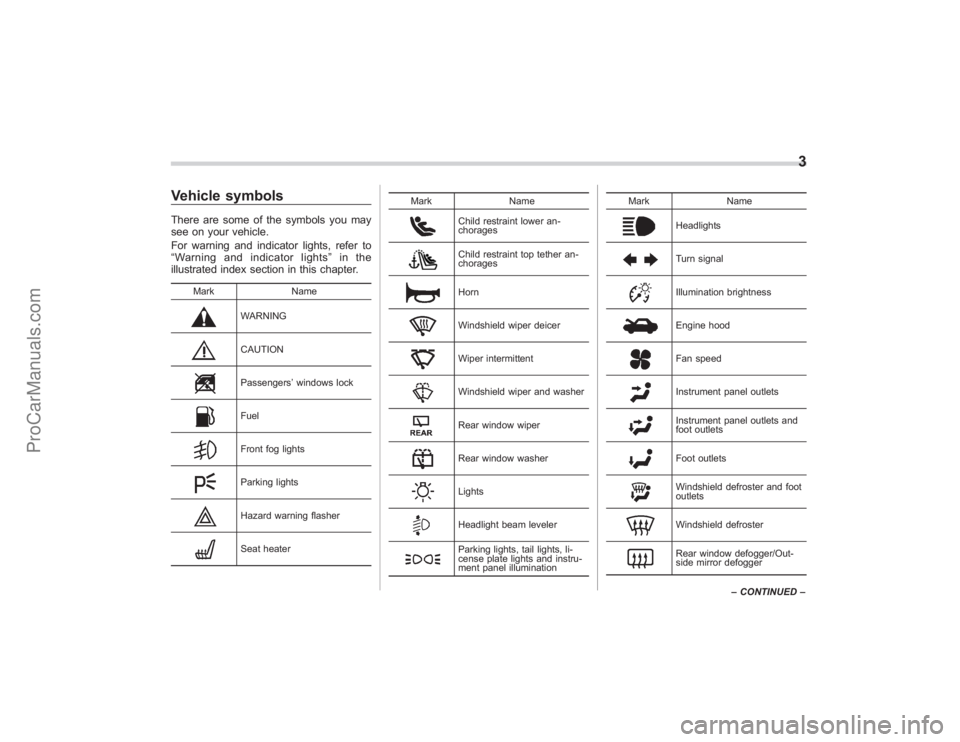
Vehicle symbolsThere are some of the symbols you may
see on your vehicle.
For warning and indicator lights, refer to
“Warning and indicator lights ”in the
illustrated index section in this chapter.
Mark Name
WARNINGCAUTIONPassengers’windows lockFuelFront fog lightsParking lightsHazard warning flasherSeat heater Mark Name
Child restraint lower an-
choragesChild restraint top tether an-
choragesHornWindshield wiper deicerWiper intermittentWindshield wiper and washerRear window wiperRear window washerLightsHeadlight beam levelerParking lights, tail lights, li-
cense plate lights and instru-
ment panel illuminationMark
Name
HeadlightsTurn signalIllumination brightnessEngine hoodFan speedInstrument panel outletsInstrument panel outlets and
foot outletsFoot outletsWindshield defroster and foot
outletsWindshield defrosterRear window defogger/Out-
side mirror defogger
3
–CONTINUED –
ProCarManuals.com
Page 7 of 409
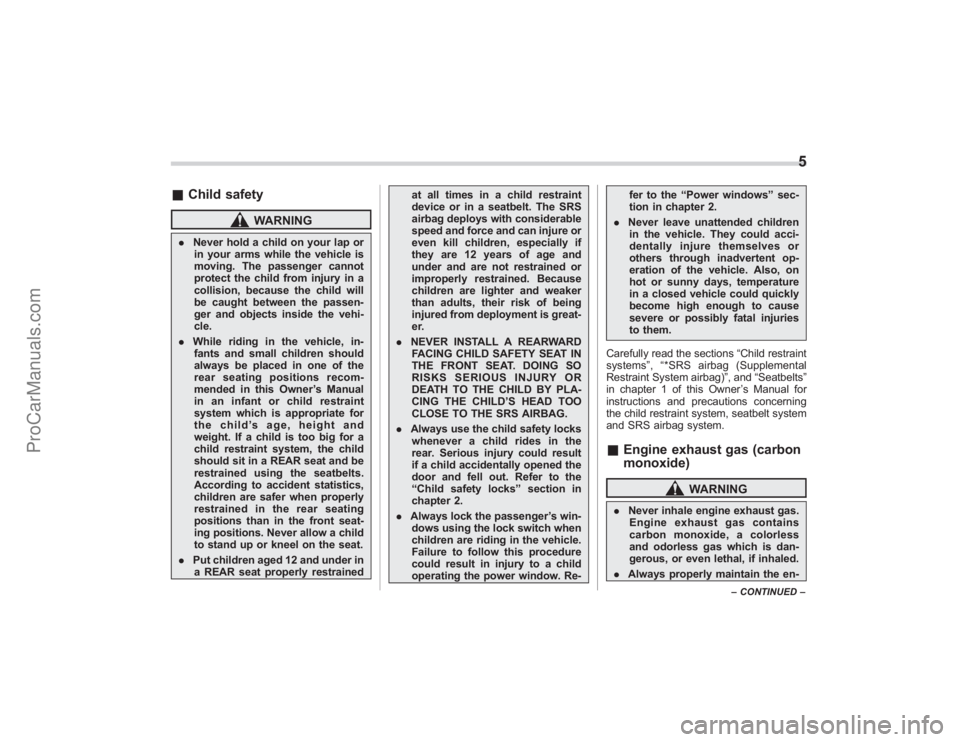
&Child safety
WARNING
. Never hold a child on your lap or
in your arms while the vehicle is
moving. The passenger cannot
protect the child from injury in a
collision, because the child will
be caught between the passen-
ger and objects inside the vehi-
cle.
. While riding in the vehicle, in-
fants and small children should
always be placed in one of the
rear seating positions recom-
mended in this Owner ’s Manual
in an infant or child restraint
system which is appropriate for
the child ’s age, height and
weight. If a child is too big for a
child restraint system, the child
should sit in a REAR seat and be
restrained using the seatbelts.
According to accident statistics,
children are safer when properly
restrained in the rear seating
positions than in the front seat-
ing positions. Never allow a child
to stand up or kneel on the seat.
. Put children aged 12 and under in
a REAR seat properly restrained at all times in a child restraint
device or in a seatbelt. The SRS
airbag deploys with considerable
speed and force and can injure or
even kill children, especially if
they are 12 years of age and
under and are not restrained or
improperly restrained. Because
children are lighter and weaker
than adults, their risk of being
injured from deployment is great-
er.
. NEVER INSTALL A REARWARD
FACING CHILD SAFETY SEAT IN
THE FRONT SEAT. DOING SO
RISKS SERIOUS INJURY OR
DEATH TO THE CHILD BY PLA-
CING THE CHILD ’S HEAD TOO
CLOSE TO THE SRS AIRBAG.
. Always use the child safety locks
whenever a child rides in the
rear. Serious injury could result
if a child accidentally opened the
door and fell out. Refer to the
“ Child safety locks ”section in
chapter 2.
. Always lock the passenger ’s win-
dows using the lock switch when
children are riding in the vehicle.
Failure to follow this procedure
could result in injury to a child
operating the power window. Re- fer to the
“Power windows ”sec-
tion in chapter 2.
. Never leave unattended children
in the vehicle. They could acci-
dentally injure themselves or
others through inadvertent op-
eration of the vehicle. Also, on
hot or sunny days, temperature
in a closed vehicle could quickly
become high enough to cause
severe or possibly fatal injuries
to them.
Carefully read the sections “Child restraint
systems ”, “*SRS airbag (Supplemental
Restraint System airbag) ”, and“Seatbelts ”
in chapter 1 of this Owner ’s Manual for
instructions and precautions concerning
the child restraint system, seatbelt system
and SRS airbag system.
& Engine exhaust gas (carbon
monoxide)
WARNING
. Never inhale engine exhaust gas.
Engine exhaust gas contains
carbon monoxide, a colorless
and odorless gas which is dan-
gerous, or even lethal, if inhaled.
. Always properly maintain the en-
5
–CONTINUED –
ProCarManuals.com
Page 14 of 409
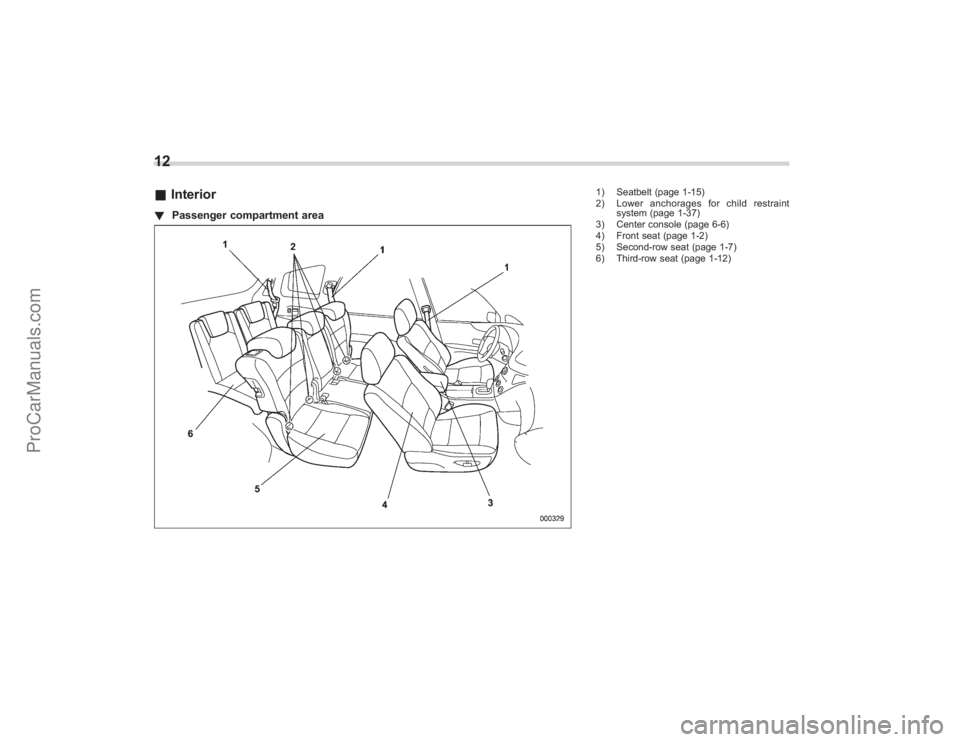
12&Interior! Passenger compartment area
1) Seatbelt (page 1-15)
2) Lower anchorages for child restraint
system (page 1-37)
3) Center console (page 6-6)
4) Front seat (page 1-2)
5) Second-row seat (page 1-7)
6) Third-row seat (page 1-12)
ProCarManuals.com
Page 25 of 409
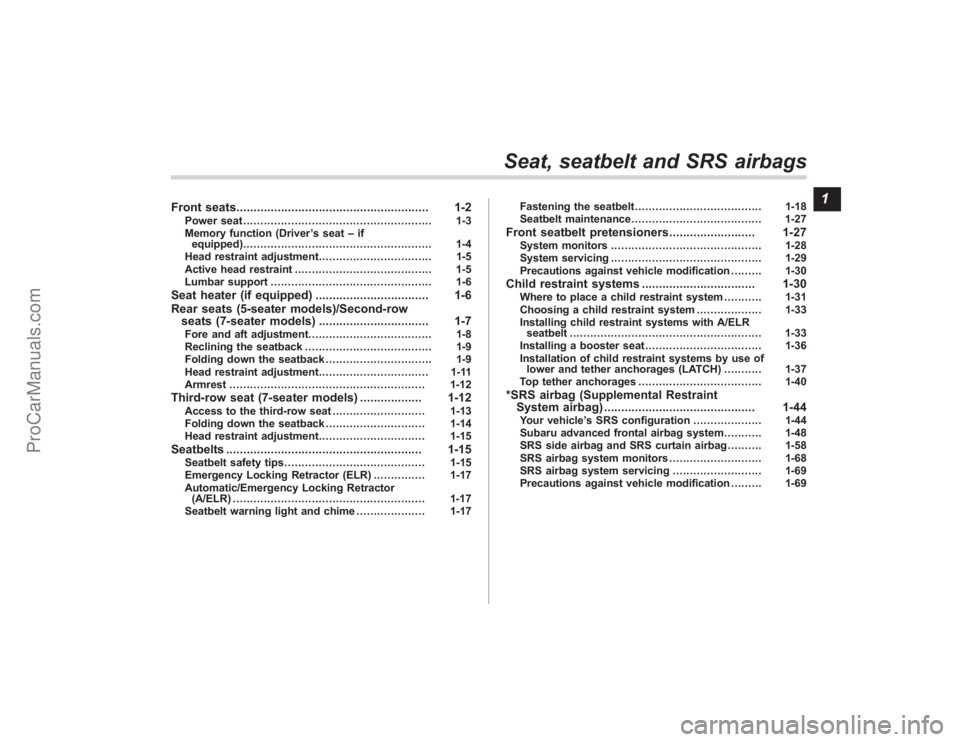
Front seats........................................................ 1-2
Power seat....................................................... 1-3
Memory function (Driver ’s seat –if
equipped) ....................................................... 1-4
Head restraint adjustment ................................. 1-5
Active head restraint ........................................ 1-5
Lumbar support ............................................... 1-6
Seat heater (if equipped) ................................. 1-6
Rear seats (5-seater models)/Second-row seats (7-seater models) ................................ 1-7
Fore and aft adjustment.................................... 1-8
Reclining the seatback ..................................... 1-9
Folding down the seatback ............................... 1-9
Head restraint adjustment ................................ 1-11
Armrest ......................................................... 1-12
Third-row seat (7-seater models) .................. 1-12
Access to the third-row seat........................... 1-13
Folding down the seatback ............................. 1-14
Head restraint adjustment ............................... 1-15
Seatbelts......................................................... 1-15
Seatbelt safety tips ......................................... 1-15
Emergency Locking Retractor (ELR) ............... 1-17
Automatic/Emergency Locking Retractor (A/ELR) ........................................................ 1-17
Seatbelt warning light and chime .................... 1-17Fastening the seatbelt
..................................... 1-18
Seatbelt maintenance...................................... 1-27
Front seatbelt pretensioners ......................... 1-27
System monitors............................................ 1-28
System servicing ............................................ 1-29
Precautions against vehicle modification ......... 1-30
Child restraint systems................................. 1-30
Where to place a child restraint system ........... 1-31
Choosing a child restraint system ................... 1-33
Installing child restraint systems with A/ELR seatbelt ........................................................ 1-33
Installing a booster seat .................................. 1-36
Installation of child restraint systems by use of lower and tether anchorages (LATCH) ........... 1-37
Top tether anchorages .................................... 1-40
*SRS airbag (Supplemental Restraint
System airbag) ............................................ 1-44
Your vehicle’s SRS configuration .................... 1-44
Subaru advanced frontal airbag system ........... 1-48
SRS side airbag and SRS curtain airbag .......... 1-58
SRS airbag system monitors ........................... 1-68
SRS airbag system servicing .......................... 1-69
Precautions against vehicle modification ......... 1-69
Seat, seatbelt and SRS airbags
1
ProCarManuals.com
Page 26 of 409
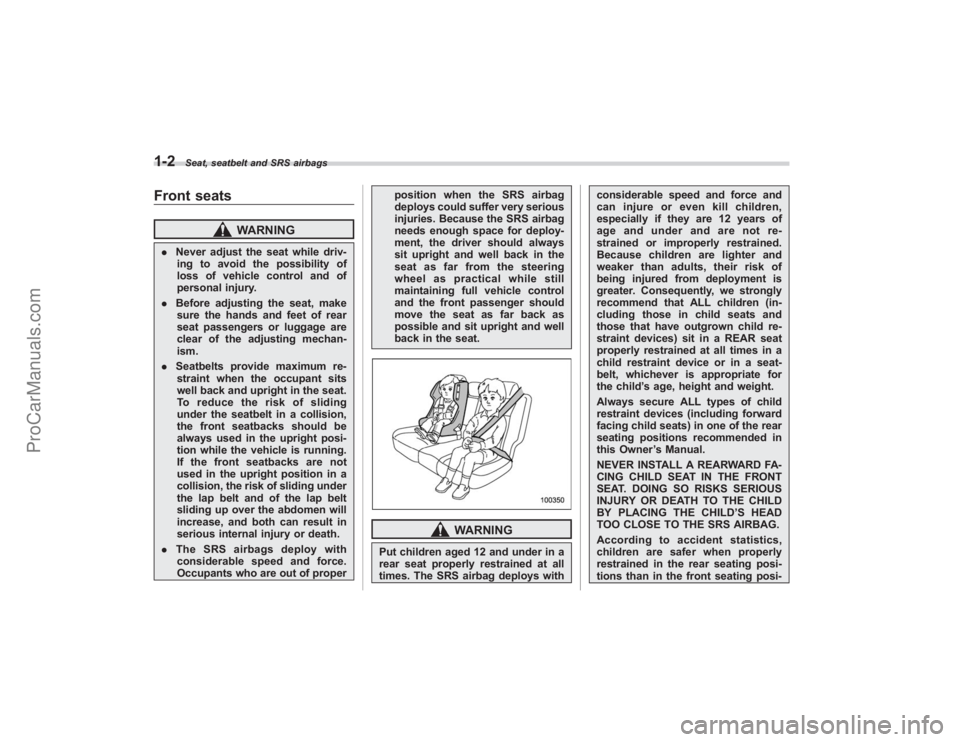
1-2
Seat, seatbelt and SRS airbags
Front seats
WARNING
.Never adjust the seat while driv-
ing to avoid the possibility of
loss of vehicle control and of
personal injury.
. Before adjusting the seat, make
sure the hands and feet of rear
seat passengers or luggage are
clear of the adjusting mechan-
ism.
. Seatbelts provide maximum re-
straint when the occupant sits
well back and upright in the seat.
To reduce the risk of sliding
under the seatbelt in a collision,
the front seatbacks should be
always used in the upright posi-
tion while the vehicle is running.
If the front seatbacks are not
used in the upright position in a
collision, the risk of sliding under
the lap belt and of the lap belt
sliding up over the abdomen will
increase, and both can result in
serious internal injury or death.
. The SRS airbags deploy with
considerable speed and force.
Occupants who are out of proper position when the SRS airbag
deploys could suffer very serious
injuries. Because the SRS airbag
needs enough space for deploy-
ment, the driver should always
sit upright and well back in the
seat as far from the steering
wheel as practical while still
maintaining full vehicle control
and the front passenger should
move the seat as far back as
possible and sit upright and well
back in the seat.
WARNING
Put children aged 12 and under in a
rear seat properly restrained at all
times. The SRS airbag deploys withconsiderable speed and force and
can injure or even kill children,
especially if they are 12 years of
age and under and are not re-
strained or improperly restrained.
Because children are lighter and
weaker than adults, their risk of
being injured from deployment is
greater. Consequently, we strongly
recommend that ALL children (in-
cluding those in child seats and
those that have outgrown child re-
straint devices) sit in a REAR seat
properly restrained at all times in a
child restraint device or in a seat-
belt, whichever is appropriate for
the child
’s age, height and weight.
Always secure ALL types of child
restraint devices (including forward
facing child seats) in one of the rear
seating positions recommended in
this Owner ’s Manual.
NEVER INSTALL A REARWARD FA-
CING CHILD SEAT IN THE FRONT
SEAT. DOING SO RISKS SERIOUS
INJURY OR DEATH TO THE CHILD
BY PLACING THE CHILD ’S HEAD
TOO CLOSE TO THE SRS AIRBAG.
According to accident statistics,
children are safer when properly
restrained in the rear seating posi-
tions than in the front seating posi-
ProCarManuals.com
Page 27 of 409
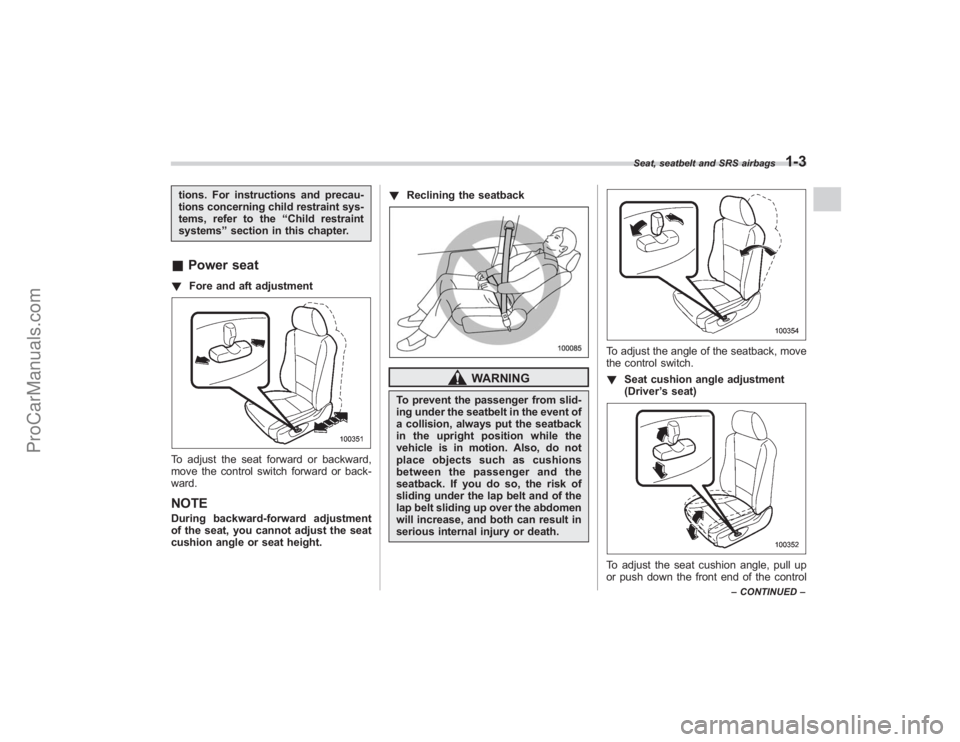
tions. For instructions and precau-
tions concerning child restraint sys-
tems, refer to the“Child restraint
systems ”section in this chapter.& Power seat! Fore and aft adjustmentTo adjust the seat forward or backward,
move the control switch forward or back-
ward.NOTEDuring backward-forward adjustment
of the seat, you cannot adjust the seat
cushion angle or seat height. !
Reclining the seatback
WARNING
To prevent the passenger from slid-
ing under the seatbelt in the event of
a collision, always put the seatback
in the upright position while the
vehicle is in motion. Also, do not
place objects such as cushions
between the passenger and the
seatback. If you do so, the risk of
sliding under the lap belt and of the
lap belt sliding up over the abdomen
will increase, and both can result in
serious internal injury or death.
To adjust the angle of the seatback, move
the control switch.
! Seat cushion angle adjustment
(Driver ’s seat)To adjust the seat cushion angle, pull up
or push down the front end of the control
Seat, seatbelt and SRS airbags
1-3
– CONTINUED –
ProCarManuals.com
Page 39 of 409
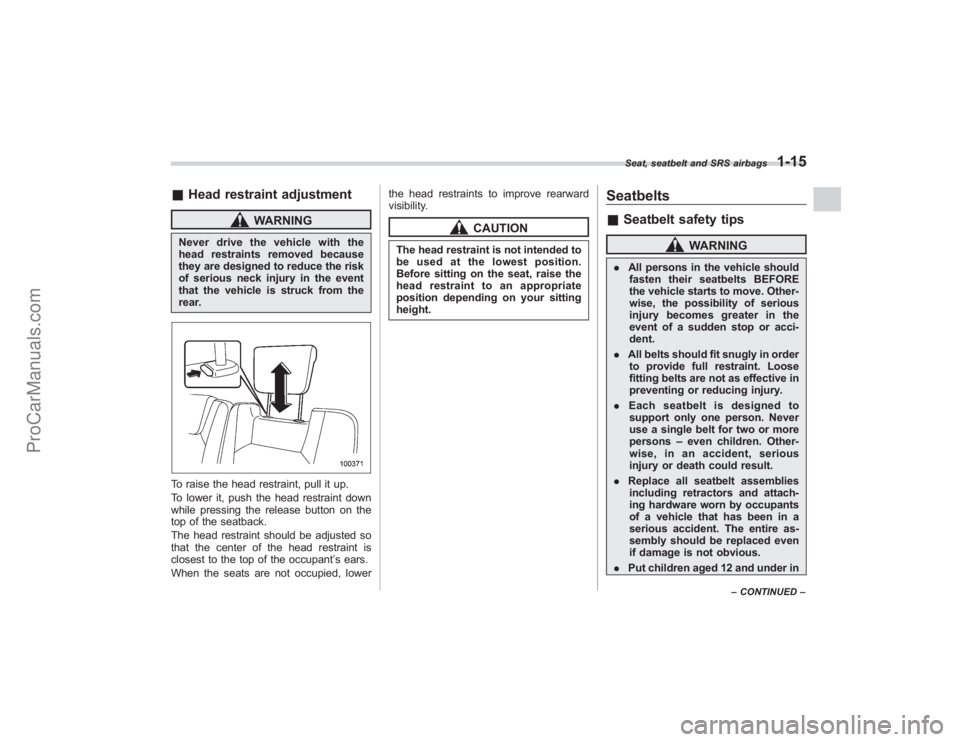
&Head restraint adjustment
WARNING
Never drive the vehicle with the
head restraints removed because
they are designed to reduce the risk
of serious neck injury in the event
that the vehicle is struck from the
rear.To raise the head restraint, pull it up.
To lower it, push the head restraint down
while pressing the release button on the
top of the seatback.
The head restraint should be adjusted so
that the center of the head restraint is
closest to the top of the occupant ’s ears.
When the seats are not occupied, lower the head restraints to improve rearward
visibility.
CAUTION
The head restraint is not intended to
be used at the lowest position.
Before sitting on the seat, raise the
head restraint to an appropriate
position depending on your sitting
height.
Seatbelts&
Seatbelt safety tips
WARNING
. All persons in the vehicle should
fasten their seatbelts BEFORE
the vehicle starts to move. Other-
wise, the possibility of serious
injury becomes greater in the
event of a sudden stop or acci-
dent.
. All belts should fit snugly in order
to provide full restraint. Loose
fitting belts are not as effective in
preventing or reducing injury.
. Each seatbelt is designed to
support only one person. Never
use a single belt for two or more
persons –even children. Other-
wise, in an accident, serious
injury or death could result.
. Replace all seatbelt assemblies
including retractors and attach-
ing hardware worn by occupants
of a vehicle that has been in a
serious accident. The entire as-
sembly should be replaced even
if damage is not obvious.
. Put children aged 12 and under inSeat, seatbelt and SRS airbags
1-15
–CONTINUED –
ProCarManuals.com
Page 40 of 409
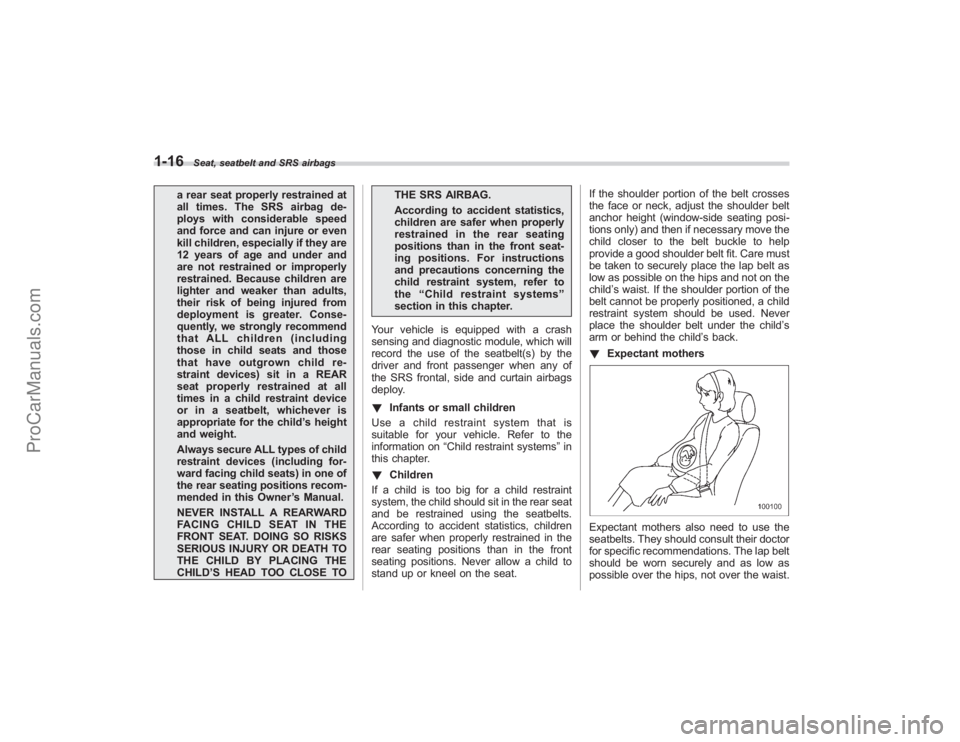
1-16
Seat, seatbelt and SRS airbags
a rear seat properly restrained at
all times. The SRS airbag de-
ploys with considerable speed
and force and can injure or even
kill children, especially if they are
12 years of age and under and
are not restrained or improperly
restrained. Because children are
lighter and weaker than adults,
their risk of being injured from
deployment is greater. Conse-
quently, we strongly recommend
that ALL children (including
those in child seats and those
that have outgrown child re-
straint devices) sit in a REAR
seat properly restrained at all
times in a child restraint device
or in a seatbelt, whichever is
appropriate for the child’s height
and weight.
Always secure ALL types of child
restraint devices (including for-
ward facing child seats) in one of
the rear seating positions recom-
mended in this Owner ’s Manual.
NEVER INSTALL A REARWARD
FACING CHILD SEAT IN THE
FRONT SEAT. DOING SO RISKS
SERIOUS INJURY OR DEATH TO
THE CHILD BY PLACING THE
CHILD ’S HEAD TOO CLOSE TO THE SRS AIRBAG.
According to accident statistics,
children are safer when properly
restrained in the rear seating
positions than in the front seat-
ing positions. For instructions
and precautions concerning the
child restraint system, refer to
the
“Child restraint systems ”
section in this chapter.
Your vehicle is equipped with a crash
sensing and diagnostic module, which will
record the use of the seatbelt(s) by the
driver and front passenger when any of
the SRS frontal, side and curtain airbags
deploy.
! Infants or small children
Use a child restraint system that is
suitable for your vehicle. Refer to the
information on “Child restraint systems ”in
this chapter.
! Children
If a child is too big for a child restraint
system, the child should sit in the rear seat
and be restrained using the seatbelts.
According to accident statistics, children
are safer when properly restrained in the
rear seating positions than in the front
seating positions. Never allow a child to
stand up or kneel on the seat. If the shoulder portion of the belt crosses
the face or neck, adjust the shoulder belt
anchor height (window-side seating posi-
tions only) and then if necessary move the
child closer to the belt buckle to help
provide a good shoulder belt fit. Care must
be taken to securely place the lap belt as
low as possible on the hips and not on the
child
’s waist. If the shoulder portion of the
belt cannot be properly positioned, a child
restraint system should be used. Never
place the shoulder belt under the child ’s
arm or behind the child ’s back.
! Expectant mothers
Expectant mothers also need to use the
seatbelts. They should consult their doctor
for specific recommendations. The lap belt
should be worn securely and as low as
possible over the hips, not over the waist.
ProCarManuals.com